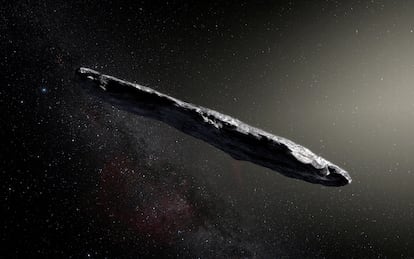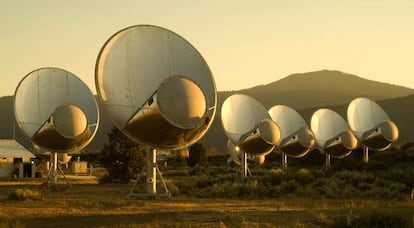The search for extraterrestrial life forms: Will we ever be able to confirm their existence?
Every so often, news breaks about the discovery of an unexplained alien object, but the claims never hold up to intense scientific scrutiny. The quest goes on regardless


In 1967, a young Irish research student named Jocelyn Bell Burnell detected a strange signal coming from the radio telescope she was working with. It was a series of short pulses every 1.3 seconds, which came up every day at the same time according to sidereal time (a timekeeping system based on the rotation of the Earth relative to the stars rather than the Sun). This indicated that the signal was coming from outer space. But the 1.3-second interval between pulses was much shorter and more regular than all pulsating sources known at the time. Nothing like this had ever been detected before, and as Bell Burnell later admitted, the thought crossed her mind: had she caught signals from an alien civilization? Neither she nor her thesis supervisor mentioned the idea in public, but the press still filled up with stories about little green men trying to communicate with humans.
A few months later, the astronomers Thomas Gold and Fred Hoyle identified the origin of these signals, or at least offered an explanation that did not involve aliens: neutron stars. The existence of these objects had been predicted in 1933 by Walter Baade and Fritz Zwicky as the final evolutionary stage of a supernova. These objects emit radiation along their magnetic poles which, due to their rapid rotation, we only see intermittently, just like the beam from a lighthouse on the coast.
Sherlock Holmes, the famous character created by British author Arthur Conan Doyle, used to say that “when you have eliminated the impossible, whatever remains, however improbable, must be the truth.” The detective was making a logically correct statement, that the improbable is statistically superior to the impossible. But it is precisely this illusion of logic that makes Sherlock Holmes’s argument so misleading, and by far the cause of so many false announcements of alien discoveries in the news. The universe is stranger than we can imagine, and it would be arrogant to presume that we are already familiar with all the possible non-extraterrestrial phenomena that might lead to a given astronomical observation.
A very good example of this is ‘Oumuamua, a strange elongated object that passed through our solar system a few years ago. ‘Oumuamua showed up as a reddish, palpitating, very faint stain in the sky. It was not a normal object. It was around 400 meters long (1,312 ft) and 40 meters wide (131 ft) and it was spinning at great speed. Its first observers, a team of astronomers from Hawaii University, gave it its name, which roughly means “first distant messenger.” Besides its shape, observers were baffled by its trajectory and great velocity, which increased the further away it moved from the Sun, in violation of Kepler’s second law of planetary motion. This behavior has also been observed in comets due to something known as outgassing, when the heat from the Sun melts their ice and releases gases that propel the comets forward, creating their beautiful tails. But ‘Oumuamua had no tail.
A renowned astrophysicist from Harvard University, Avi Loeb, came out to say that ‘Oumuamua was an alien object, more specifically that it could be an artificial thin solar sail accelerated by solar radiation pressure. But scientists from the University of Arizona concluded, after a detailed analysis, that it could be a fragment from a dwarf planet or Pluto-like asteroid that was propelled into interstellar space by the force of an impact. Pluto also has a reddish tinge due to the radiation that processes its surface methane into hydrocarbons and could accelerate like comets through the outgassing of nitrogen ice, which is very abundant on these types of objects. But this outgassing would be invisible. Again, this might or might not be a correct or complete explanation, but it shows that there are perfectly plausible natural explanations for ‘Oumuamua without having to resort to extraterrestrials.

Tabby’s Star is another good example. Discovered by Tabetha Boyajian in 2011, this star showed very unusual dips in light that had never been seen before and for which there were no logical explanations. After ruling out several hypotheses, a few scientists suggested the possibility of an alien megastructure that might be blocking its light, something akin to what is known as Dyson spheres, hypothetical structures that completely encompass a star to capture most of its radiation. This theory was based on the fact that no known natural phenomenon could easily explain the observations, and for a while, the idea had a lot of traction. The world’s largest radio telescopes were quickly pointed in its direction, not to mention the antennas of the SETI (Search for Extraterrestrial Intelligence) network. Since then, new data has shown that the light dips do not equally affect all colors, as would be expected of an opaque structure, and that they are quite similar to the effect produced by cosmic dust, which lets more red light through than blue. There are still many things left to explain, but current hypotheses point to cosmic dust from a recently destroyed planet or satellite as the most likely cause.
But let’s not completely dash our hopes of discovering alien life and consider a few findings that are still without satisfactory natural explanations. Many readers may have heard of the Wow! signal, a strange narrowband radio signal detected in August 1977 by Big Ear, the radio telescope of Ohio State University. No simple explanation has been offered yet for this signal, and no more signals like it have ever been detected again. Or have they? On April 29, 2019, the Parkes radio telescope was pointing at our closest stellar neighbor, a star known as Proxima Centauri, when it detected an emission peak at a frequency of 982.002 MHz that gradually moved to higher frequencies over the next three hours.
The signal went undetected for over a year until a student working on the Breakthrough Listen extraterrestrial search project looked at the data again. There are many sources of radio signals in the sky and most are made by humans. But Breakthrough Listen has detailed protocols to filter them out. This signal made it past the filters due to its frequency movement and the fact that it was only detected when the telescope was pointing at Proxima Centauri and not at another spot in the sky. This is especially exciting because Proxima Centauri has a planetary system that includes a planet with a mass similar to Earth’s, which is located at the right distance from Proxima to make it possible to have liquid water on its surface. If a frequency increase means the signal is getting closer, does it mean there’s an invading fleet of Proximans coming towards us? There are several good reasons to think not. For instance, Proxima Centauri is a red dwarf that is dangerously active, with multiple flares and coronal mass ejections, so that a planetary atmosphere is unlikely to survive its outbursts. Besides, the signals are spaced out in regular frequency intervals and these seem to be multiples of frequencies commonly used in the oscillators of our electronic devices. This tips the balance back to the boring side, even though the specific source of the interference has not been identified. On the other hand, the fact that the signal cannot be detected when the telescope is not pointed at Proxima Centauri is certainly odd.
The fact is, observation of the universe never ceases to surprise us with new phenomena, and although the alien idea routinely makes a comeback, in every case a natural culprit is ultimately always found. Does this mean that we will never be able to confirm the existence of extraterrestrials based on our observations of the sky? When will we be able to assert that a new clue is unequivocal evidence of extraterrestrial life? Believe me, if the clue was delivered by aliens, the evidence would mount. Most scientists want there to be extraterrestrials; they want it more than anyone else, and they will be the first to jump for joy when the most probable interpretation of the data points at extraterrestrial life forms. Right now this is not the case, but millions of dollars, many hours of work and a lot of effort are being poured into trying to make it so, so that we may one day finally be able to announce that we are not the only intelligent beings in all of space-time.
Tu suscripción se está usando en otro dispositivo
¿Quieres añadir otro usuario a tu suscripción?
Si continúas leyendo en este dispositivo, no se podrá leer en el otro.
FlechaTu suscripción se está usando en otro dispositivo y solo puedes acceder a EL PAÍS desde un dispositivo a la vez.
Si quieres compartir tu cuenta, cambia tu suscripción a la modalidad Premium, así podrás añadir otro usuario. Cada uno accederá con su propia cuenta de email, lo que os permitirá personalizar vuestra experiencia en EL PAÍS.
¿Tienes una suscripción de empresa? Accede aquí para contratar más cuentas.
En el caso de no saber quién está usando tu cuenta, te recomendamos cambiar tu contraseña aquí.
Si decides continuar compartiendo tu cuenta, este mensaje se mostrará en tu dispositivo y en el de la otra persona que está usando tu cuenta de forma indefinida, afectando a tu experiencia de lectura. Puedes consultar aquí los términos y condiciones de la suscripción digital.
More information
Últimas noticias
Christmas Eve for Christians in Gaza: Confinement, no toys, and explosions near the church
AfD, a key pawn for Trump in Europe, strengthens ties with Washington
From cook to sniper: Ukrainian women fight for equality in the army
Trump succeeds in increasing deportations by hiring military personnel to act as judges
Most viewed
- Christian Louboutin: ‘Young people don’t want to be like their parents. And if their parents wear sneakers, they’re going to look for something else’
- Cartels in Mexico take a leap forward with narco-drones: ‘It is criminal groups that are leading the innovation race’
- ‘El Limones’ and the growing union disguise of Mexican organized crime
- Liset Menéndez de la Prida, neuroscientist: ‘It’s not normal to constantly seek pleasure; it’s important to be bored, to be calm’
- The low-cost creative revolution: How technology is making art accessible to everyone










































